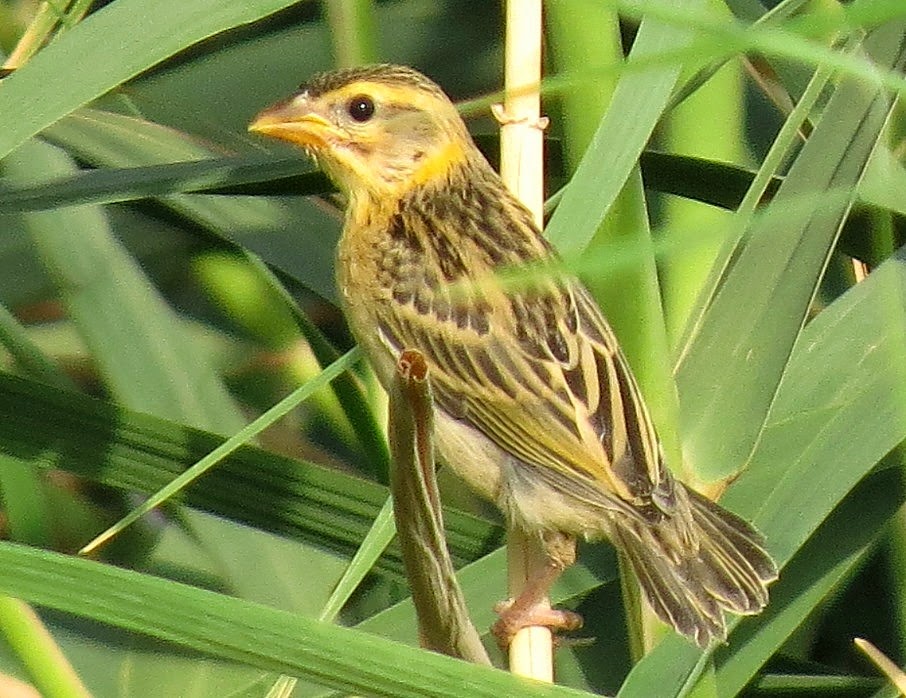After the summer, I will be working in Salalah, Oman where the birding promises to be superb. However, I am not done with Saudi Arabia. I fully intend to come back in the future but more than likely to a different geographic location.
So Friday was a farewell to Al Hayer. I was lucky enough to see plenty of summer warblers close up and in prolonged fashion. I blogged about that yesterday. This blog looks at the other birds seen.
Al Hayer in summer is a good place to "exotic" and natural members of the finch family. The pivot fields help supply seeds as food and the water is a scarce necessity in summer.
It is among the most southerly places on earth that Spanish sparrow breed.
male Spanish sparrow
Of course they are house sparrow too. The other natural finch we sometimes see at Al Hayer is desert finch but I saw none on Friday.
streaked weaver
Streaked weaver must have escaped a generation ago and is thriving despite accidental and planned reed burnings over the years. On Friday there were very many. It has been a good year for them.
.
male streaked weaver
Indian silverbill
Nobody knows where Indian silverbill arrived here by natural range expansion or escapes or both. I did managed to observe them in a couple of places.
white eared bulbul
The white eared bulbul of the area is not the sub species found naturally in eastern province. This wide spread bird is a product of escapes but is expanding west and north far away from the greater Riyadh area.
river along a field
Darting in and out of cover all morning were plenty of moorhen which is a very shy bird in Saudi Arabia.
adult moorhen
Most of the birds now are adults or juveniles. The fledglings of two or three months ago have grown up.
juvenile moorhen
black winged stilt
Several black winged stilt and a couple of mallard were spotted near the water near some of the moorhen. Both birds breed at Al Hayer.
juvenile black winged stilt
There are always large numbers of doves all year round. Eurasian collared dove, laughing dove and Namaqua dove were all observed in large numbers.
adult male Namaqua dove
Namaqua dove is active even in the fiercest heat but equally it needs to drink more and is most easily seen doing just that.
juvenile Namaqua dove
They have finished breeding here for this year too.
juvenile black crowned night heron
Some of the heron family are at Al Hayer in summer. I saw more little bittern than any other but failed to produce a useful photograph.
I suspect from past observations, the most common heron at this time of year is actually black crowned night heron but they roost deep these days. Five were seen flying at various times including a juvenile.
purple heron
black bush robin
Both black bush robin and rufous bush robin were seen. The former is resident.
The only other birds not previously mentioned but spotted were little green bee-eater and white throated kingfisher.
red eared slider
I have often seen other fauna at Al Hayer even including baboons! This time the most exotic was an aged red eared slider.
The 25 species seen at Al Hayer on Friday
Mallard
|
Crested lark
|
Little bittern
|
Pale crag martin
|
Black crowned night heron
|
Barn swallow
|
Squacco heron
|
Graceful prinia
|
Purple heron
|
Eastern olivaceous warbler
|
Moorhen
|
Eurasian reed warbler
|
Namaqua dove
|
Rufous bush robin
|
Eurasian collared dove
|
Black bush robin
|
Laughing dove
|
Spanish sparrow
|
Hoopoe
|
House sparrow
|
White throated kingfisher
|
Indian silverbill
|
Little green bee-eater
|
Streaked weaver
|
White eared bulbul
|

















Very surprised to hear you're leaving Saudi, Rob. And going to Salalah - I didn't know there were jobs down that way. I may well see you there in the autumn, as I've been planning a trip there for some time. Meanwhile, when will you be in Varna? And I trust there are no problems with flooding in your village? I hear there was flooding in Kranevo.
ReplyDeleteAndrew
Andrew, I will be back to Saudi but need a year out in Oman. I'll give you contact details when I have them. I'll be in Varna in mid July and then again for most of August. As for the rain, I had my place checked a couple of days ago and its unscathed. See you in BG
ReplyDeletesorry to hear this hope to see you soon back in our country, hopefully you can come to Jeddah. sure you will find it an interesting city for birds. you will sure enjoy the Nile Valley sunbird, our beautiful colorful noisy little brat..
ReplyDeletestarted to do a new blog, will send you a link ASA it start to take shape.
best wishes.
Ammadoux,
ReplyDeleteThank you for your kind words. I will be back. Oman is a break not the end. I look forward to seeing your blog. Keep in touch. Rob